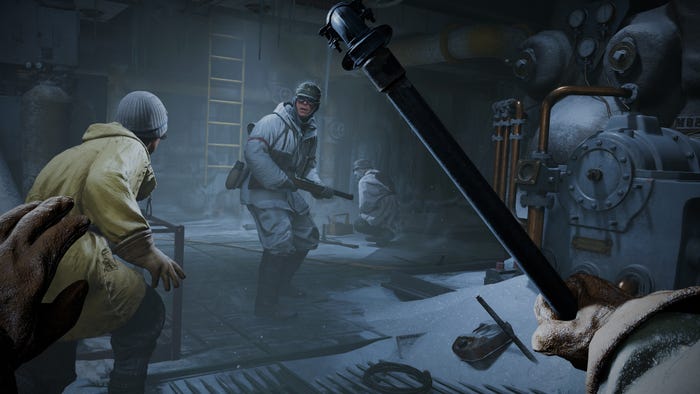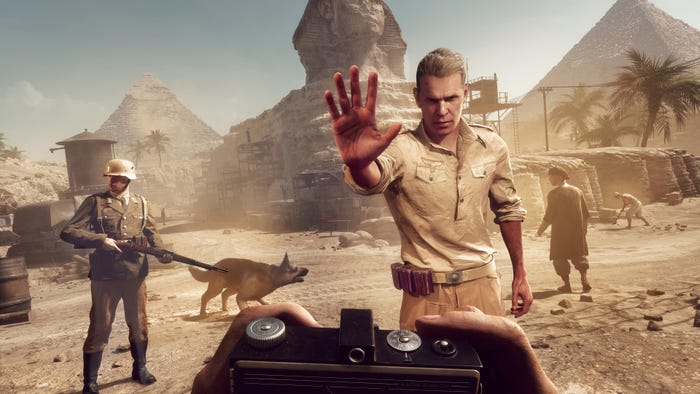Trending
Opinion: How will Project 2025 impact game developers?
The Heritage Foundation's manifesto for the possible next administration could do great harm to many, including large portions of the game development community.

The Indiana Jones film series has been an iconic part of pop culture, brimming with a pulp-style sense of action and spirit of adventure. However, there haven't been many modern video games starring the globetrotting explorer, even as the series has undoubtedly inspired other well-known games like Tomb Raider and Uncharted.
That's changing with the upcoming Indiana Jones and The Great Circle, helmed by developer MachineGames, who've previously worked on Wolfenstein: The New Order and its sequel, The New Colossus. A first-person action adventure game focusing on the events between Raiders of the Lost Ark and The Last Crusade, The Great Circle puts a more immersive spin on the escapades of the famed adventurer as he explores tombs and pummels fascists.
After playing the opening hours at a recent hands-on event, I got a clearer view of MachineGames' take on an Indiana Jones game, which emphasizes player agency and open-ended exploration. I also spoke with design director Jens Andersson, where he explained how The Great Circle is all about letting players come up with in-the-moment solutions for the game's challenges. .
The Great Circle positions itself as a new adventure during the peak of Indiana Jones' career as an archeologist and occasional college professor. With that conceit, the game focuses on building up the atmosphere and heightened reality for its core combat, stealth, and exploration gameplay sequences, all focused on a protagonist who has to scrape and improvise his way to success. For instance, using Jones' whip was incredibly satisfying for disarming foes or softening up targets to set them up for a finishing blow with an empty rifle used as an improvised club. Many encounters feel like they came out of a movie, and that kind of scrappy and sometimes comedic energy is what design director Jens Andersson wanted to recreate for the game.
"That sense of improvisation is very 'Indy,' isn't it? All of the actions you can do in the game have to make sense for the character, and how we've built it up is something we're very proud of," said Andersson. "Player agency is really important for us, so if an enemy has a gun and he drops it, you should be able to pick it up, and you have a revolver. It's iconic for the character, but in this game, there are many times when you don't want to use it. My favorite part is seeing testers play the game, and there's like a rifle here, and there's a banjo here; everyone picks up the banjo instead because it's just more fun to beat up enemies with, and it also fits the character that you want to play as."

Image via MachineGames/Microsoft.
Following the theft of a mysterious artifact from Marshall College, the titular hero (played by Troy Baker) embarks on a new adventure that'll take him to Northern Africa, Vatican City, and other locales as he uncovers an ancient conspiracy that puts him in the crosshairs of the growing Nazi empire.
This setup is very much in line with the film series, but as a video game, there are more opportunities to explore and interact with the characters within the setting. What surprised me most about the opening hours of The Great Circle is that the game is not a totally linear story experience, but rather, it features some fairly open-ended levels that offer up different ways to acquire knowledge and fight bad guys as Indiana Jones.
Speaking with the design director, he stated that the developers were not interested in making a standard licensed game adaptation but wanted to dig deeper into an immersive experience that lives up to the classic LucasArts games—such as the seminal 1992 adventure game The Fate of Atlantis.
"I really love the whole legacy of LucasArts, and we're trying to evoke that sense of adventure from those games," said the design director. "We're doing something very different with The Great Circle, but because we're building off such a legacy of classic adventure games, we have a little more confidence that we can do a modern adventure game as well. It's proven to fit well with the Indiana Jones IP, and now we get to do it on a grand scale in 2024, and that's very exciting for us."
Along with being able to walk around the environment to examine notes and artifacts, you can explore to find hidden passages, clues to side activities, and open-ended combat encounters that can be cleared with fisticuffs or stealthily knocking out foes with whatever players can find. There was a strong sense of player agency, and it reminded me of a similar feeling I play an immersive sim like Deus Ex. However, Anderson stated they were trying to avoid going too deep into that sort of flexibility, rather focusing more on prioritizing improvisation within sandbox environments.
Developer MachineGames is mainly known today for the bombastic and surprisingly introspective Wolfenstein games. However, the studio is made up of developers who previously worked at Starbreeze, building games such as The Chronicles of Riddick: Escape from Butcher Bay and The Darkness. Playing The Great Circle showed more of a stronger pull from the dev's early games, which the design director stated has been a part of the studio's signature ethos.
"There's almost this kind of muscle memory that MachineGames has been growing consistently from project to project, and many of us have worked together since The Chronicles of Riddick and The Darkness [going back to Starbreeze]," said Andersson. "You build up a way of going about things—which can be hard to do, as game development can feel like turning an aircraft carrier. But what it came down to was that the story needed to come first, and that turned into building the kind of adventure we want to take you on and then building the game features, the pace, and the characters all based around you being Indiana Jones."

Image via MachineGames/Microsoft.
In many ways, The Great Circle feels like a successor to The Chronicles of Riddick, mainly its focus on balancing first-person action and stealth within an immersive story-driven experience. The Chronicles of Riddick's video game adaptation was particularly successful because it didn't directly adapt the film material. Instead, Escape from Butcher Bay was more interested in capturing the moment-to-moment experience of being an action hero protagonist that was unique to the interactive experience of the video game medium—and The Great Circle looks to carry on with that same approach.
One of my favorite sections from the opening hours, one that encapsulates the structure of the game well, was the Giza Pyramids, the game's first open sandbox level. While you have a clear goal to get inside a secure tomb, surrounding the ruins are Nazi base camps on the lookout for Jones, along with settlements filled with civilians going about their routines. This section felt very much like an Assassin's Creed-style social stealth sandbox. After gathering intel and scouting ahead with a camera, I had to acquire a disguise or cover to sneak into closely guarded areas.
When it came to building out these levels, Andersson admits it was a bit risky and scary to design levels with this sort of variation, as the prevailing worry was that players would opt to skip the side activities that help build the world. Still, he reasons that it was worth having them.
"We have a bunch of sections that are linear and more story focused, but there are a number of larger areas like the Vatican and Giza that feature a ton of content there that are entirely up to you to engage with it or not," he said.

Image via MachineGames/Microsoft.
"From a developer point of view, it's a little bit scary for us to have open-ended levels with side content because we spend so much time on it and players might end up skipping it, but that's also why we have this revisit feature in the game. So even when you complete it you can jump back to earlier chapters and then sort of play the content that you didn't discover the first time around to see the little mysteries and encounters you missed. That's one of the things I'm most happy about with the game, and I'm interested to see what people think about it."
What I found most interesting about Indiana Jones and The Great Circle is that it's an action adventure game that's all about getting players to feel resourceful and cunning in their approach to overcoming the odds—like picking up a banjo to clobber fascists. Given the large scope, and the density of its locales, it's an ambitious take on bringing the full Indiana Jones experience to a video game, and I was impressed to see how much detail and variety there was packed into the few areas I got to explore. .
So far, Indiana Jones' big return to the world of video games shows a new side to the character and its pulpy sense of adventure, and for the design director, he believes that the developers of The Great Circle have already nailed its most important goal.
"It's all coming together nicely, we're still working all the way to the end," said the design director. "I'm less scared about the riskier design choices we have made, because we've kind of proven that they work. We have people play through the full game now and I just really love how the story has turned out. The whole point of this game is to get you to feel like Indiana Jones, and that's the thing I feel we most succeeded at."
You May Also Like